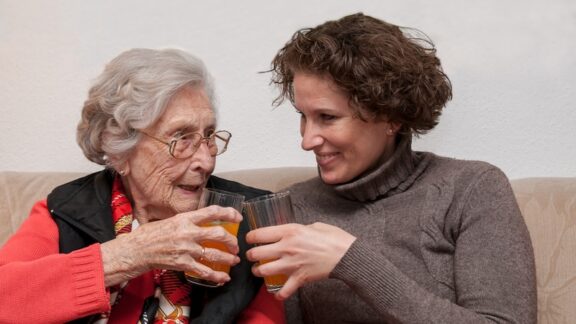As designer Lisa Cini shared her home with three other generations, she began to apply her expertise to making the space more livable for everyone. She calls her system the LOVE method of aging in place. Seniors Guide writer Kari Smith spoke with Cini about her ideas.
“The secret to successful aging is being able to make decisions for yourself before someone else has to make them for you,” says Lisa Cini, expert in Alzheimer’s and long-term care design and founder of Mosaic Design Studio. She believes that great design is good for everyone.
Her distinctive “LOVE” method has become her foremost strategy in crafting designs for senior living. She began developing the acronym and the system it describes while learning to embrace multigenerational living when her grandmother and parents moved in to her home.
The LOVE method of aging in place
The acronym LOVE stands for Light, Optimization, Visual, and Ease.
Light
Lisa emphasizes the paramount importance of Light as a crucial element, particularly for seniors grappling with vision impairments like glaucoma or cataracts. Here are some insights she shares:
- Nightlights are indispensable, and substituting them with faint light filtering through a slightly opened door is not advisable. (Seniors Guide note: since sleep experts recommend darkness for best sleep, you can opt for motion-activated nightlights in the bedroom.)
- Opt for amber-colored light over blue light when selecting a nightlight, as it is gentler on the eyes.
- While natural light remains optimal, a reading lamp designed to mimic sunlight in both color and brightness can be advantageous for individuals unable to venture outdoors due to mobility constraints or other reasons.
- Incorporate dimmers and automatic sensors where appropriate. The market offers numerous “smart” alternatives that can be programmed to execute routines or to be operated remotely, automatically adjusting lights as needed.
- Given that bedroom and bathroom mishaps are common among seniors, ensure ample illumination in these spaces.
Optimization

Optimization in household design entails selecting items that fulfill multiple functions. For example, a grab bar in a restroom may also serve as a toilet paper holder. A mobility item may also include personal touches. Leverage home automation or use smart home systems like Alexa or Google Home to simplify everyday tasks, such as ordering medication or making phone calls.
Visual
Visual isn’t just having sufficient light – it’s making sure that elements are visible. Consider the following examples:
- Opt for a contrasting color for a handrail compared to the wall it’s mounted on.
- Paint the top step a different color to visually signal against stepping up again.
- Ensure contrast between surfaces like a wall and floor, or a table and floor. For instance, placing a wooden table on a similarly toned wooden floor might not offer enough contrast, potentially posing a tripping hazard.
She also explains that visual cues are important to seniors with Alzheimer’s and other dementias, such as putting things where they belong. For example, don’t set the table if it’s not time to eat. Additionally, seasonal decorations can serve as reminders of the time of year, contributing to a more intuitive living environment.
Ease
When it comes to Ease, the focus lies on streamlining accessibility and usability within living spaces. Consider the following examples:
- Implementing cabinet shelving that pulls out, facilitating easier access to stored items.
- Installing a pot filler faucet over a stovetop to eliminate the need for carrying heavy pots filled with water for cooking.
- Utilizing cabinets that descend to meet the user’s reach.
- Enhancing the functionality of pocket doors by adding handles for smoother operation.
When addressing preparing the home for successful aging, Cini tells me, “Preventative maintenance doesn’t often happen – we typically fix things after the fact. The LOVE method aims to teach families how to anticipate needs and create solutions that make the home safer and more user-friendly.”
Cini has shared her insights and strategies to make homes and senior communities safer and more accessible for aging adults for 30 years. She founded Mosaic Design Studio in January of 1999 and recently created the podcast “What’s Your Next Move: Aging on Your Own Terms.” Her book dedicated to the LOVE method is currently in progress. She published “Hive: The Simple Guide to Multigenerational Living: How Our Family Makes It Work” in 2017, detailing her experiences of living with four generations under one roof with topics such as shared responsibilities, space redesign for privacy, and communal areas for gathering.
As an Amazon Associate, Seniors Guide earns from qualifying purchases of linked books and other products.





